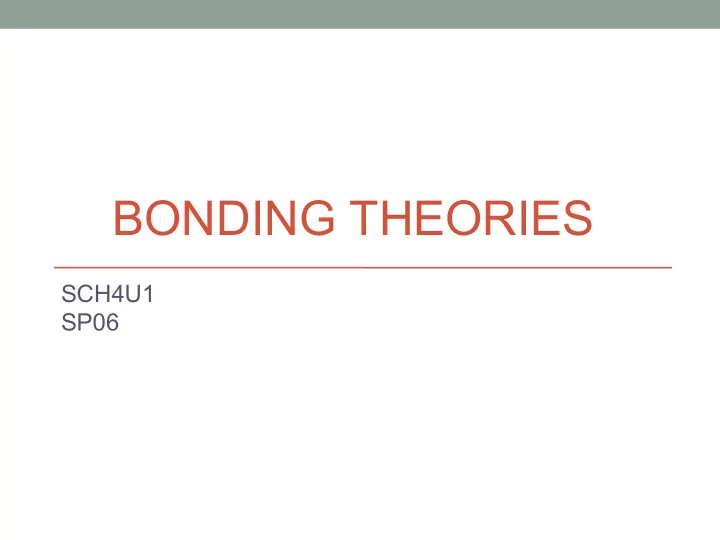

BONDING THEORIES SCH4U1 SP06
Lewis Theory of Bonding (1916) Key Points: ▪ The noble gas electron configurations are most stable. ▪ Stable octets can be formed through the transfer of electrons from metals to non-metals. ▪ Stable octets can also form through sharing of electrons between non-metals (covalent bonding). ▪ Electrons are most stable when they are paired.
Electron Dot Diagrams & Lewis Structures
Free Radicals • Atoms or molecules with unpaired electrons. • These are very reactive substances. • e.g. reactive hydroxyl radical (OH) vs. stable hydroxide ion (OH - )
Resonance • When 2 possible Lewis structures are possible, a hybrid or “resonance” structure is assumed. • Electrons are assumed to be “delocalized” • e.g. nitrite ion
Practice: Draw the Electron Dot and Lewis Structure for these covalently bonded elements, compounds or ions: F 2 a) NF 3 b) N 2 F 2 c) N 2 d) Write your answers PCl 5 e) on the board. CN - f) + NH 4 g) 2- OCl j) SO 3 h) - BrO 2 k) O 3 i)
Valence Bond (VB) Theory (1928) ▪ VB Theory is a quantum mechanical model of bonding. ▪ Covalent bonds form when a pair of half-filled orbitals overlap to form combined (or bonding) orbitals. ▪ Bonding orbitals contain 2 electrons with opposite spin. ▪ Electron density is highest between the 2 nuclei. ▪ Direct overlap of orbitals is called a sigma (σ) bond
VB Theory (continued) ▪ Overlapping orbitals can also form between s and p orbitals (e.g. HF) ▪ Combined orbital ( sigma bond) represents a lower energy state of the two atoms.
Molecular Orbital (MO) Theory (1933) ▪ Lewis Theory considers all 4 electrons around carbon to be identical. ▪ Contradicted by the Wave-Mechanical Model (1s 2 2s 2 2p 2 ) ▪ Experimental evidence confirmed the Lewis model of carbon bonding in compounds (e.g. CH 4 )! ▪ Carbon does contain 4 identical covalent bonds !?! ▪ [Complete the Orbital Representation Table Now]
Molecular Orbital Theory • States that atomic orbitals can combine to form molecular orbitals (MO) • MO are combinations of Schrodinger’s equations containing multiple nuclei. • Formation of a MO involves electron promotion & orbital hybridization.
MO Formation in Carbon A 2s electron is “promoted” into the empty p orbitals. 1) The 2s 1 2p 3 atomic orbitals undergo hybridization to form 2) 4 half-filled sp 3 bonding orbitals. Each identical sp 3 orbital can form a sigma bond with 3) another half-filled orbital.
sp 3 Hybridization and Shape ▪ Electron repulsion moves the 4 bonding orbitals as far apart as possible, forming the tetrahedral shape.
Need another explanation? Review the extra readings online 1) Watch these clips: 2) Hybridization Molecular Shape and Orbital Hybridization
Hybrid Orbitals sp hybrid Linear molecule s + p sp 2 hybrid Trigonal planar s + 2p
Hybrid Orbitals sp 3 Tetrahedral s + 3p
Other hybrids… • Exceptions to the “octet rule” involve unusual hybrids s + 3p + d sp 3 d hybridization • 5 identical bonding orbitals • Trigonal bipyramidal shape (e.g. PCl 5 )
sp 3 d 2 hybridization • s + 3p + 2d • 6 identical bonding orbitals • Octahedral shape (e.g. SF 6 )
THINKING EXERCISE Explain the weird valences of the following central atoms: • Br in BrF 5 2- • S in SO 4 - • N in NO 3 • Xe in XeF 4
Recommend
More recommend